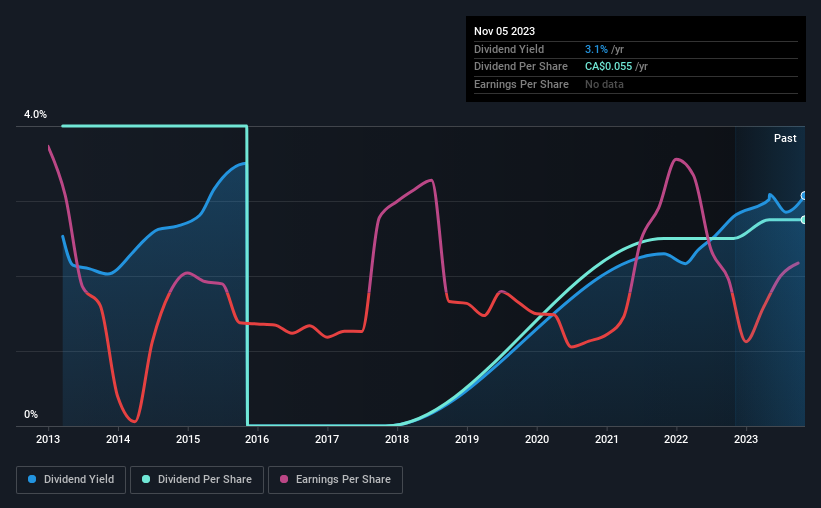Pulse Seismic Inc. (TSE:PSD) Pays A CA$0.014 Dividend In Just Four Days
Pulse Seismic Inc. (TSE:PSD) stock is about to trade ex-dividend in 4 days. The ex-dividend date is usually set to be one business day before the record date which is the cut-off date on which you must be present on the company's books as a shareholder in order to receive the dividend. The ex-dividend date is of consequence because whenever a stock is bought or sold, the trade takes at least two business day to settle. This means that investors who purchase Pulse Seismic's shares on or after the 10th of November will not receive the dividend, which will be paid on the 21st of November.
The company's next dividend payment will be CA$0.014 per share, and in the last 12 months, the company paid a total of CA$0.055 per share. Based on the last year's worth of payments, Pulse Seismic has a trailing yield of 3.1% on the current stock price of CA$1.79. Dividends are an important source of income to many shareholders, but the health of the business is crucial to maintaining those dividends. As a result, readers should always check whether Pulse Seismic has been able to grow its dividends, or if the dividend might be cut.
Check out our latest analysis for Pulse Seismic
Dividends are usually paid out of company profits, so if a company pays out more than it earned then its dividend is usually at greater risk of being cut. Pulse Seismic is paying out an acceptable 59% of its profit, a common payout level among most companies. That said, even highly profitable companies sometimes might not generate enough cash to pay the dividend, which is why we should always check if the dividend is covered by cash flow. Dividends consumed 63% of the company's free cash flow last year, which is within a normal range for most dividend-paying organisations.
It's encouraging to see that the dividend is covered by both profit and cash flow. This generally suggests the dividend is sustainable, as long as earnings don't drop precipitously.
Click here to see how much of its profit Pulse Seismic paid out over the last 12 months.
Have Earnings And Dividends Been Growing?
When earnings decline, dividend companies become much harder to analyse and own safely. If business enters a downturn and the dividend is cut, the company could see its value fall precipitously. With that in mind, we're discomforted by Pulse Seismic's 20% per annum decline in earnings in the past five years. Such a sharp decline casts doubt on the future sustainability of the dividend.
The main way most investors will assess a company's dividend prospects is by checking the historical rate of dividend growth. Pulse Seismic's dividend payments per share have declined at 3.7% per year on average over the past 10 years, which is uninspiring. It's never nice to see earnings and dividends falling, but at least management has cut the dividend rather than potentially risk the company's health in an attempt to maintain it.
The Bottom Line
Should investors buy Pulse Seismic for the upcoming dividend? While earnings per share are shrinking, it's encouraging to see that at least Pulse Seismic's dividend appears sustainable, with earnings and cashflow payout ratios that are within reasonable bounds. Bottom line: Pulse Seismic has some unfortunate characteristics that we think could lead to sub-optimal outcomes for dividend investors.
With that in mind though, if the poor dividend characteristics of Pulse Seismic don't faze you, it's worth being mindful of the risks involved with this business. Every company has risks, and we've spotted 2 warning signs for Pulse Seismic you should know about.
Generally, we wouldn't recommend just buying the first dividend stock you see. Here's a curated list of interesting stocks that are strong dividend payers.
Have feedback on this article? Concerned about the content? Get in touch with us directly. Alternatively, email editorial-team (at) simplywallst.com.
This article by Simply Wall St is general in nature. We provide commentary based on historical data and analyst forecasts only using an unbiased methodology and our articles are not intended to be financial advice. It does not constitute a recommendation to buy or sell any stock, and does not take account of your objectives, or your financial situation. We aim to bring you long-term focused analysis driven by fundamental data. Note that our analysis may not factor in the latest price-sensitive company announcements or qualitative material. Simply Wall St has no position in any stocks mentioned.

